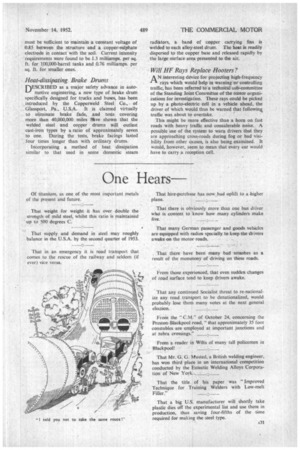Passing Comments
Page 32

Page 33

If you've noticed an error in this article please click here to report it so we can fix it.
A Man 'with a Big Mission
INTO our offices the other day came Mr. John Webb I from America. A Briton, born in South Africa, he has for years been lecturing in the U.S.A. to encourage goodwill and business co-operation between that country and Britain.
His visit here is sponsored by James Loudon and Company, 8, Mayfair Place, London, W.1, with a head office at 354, South Spring Street, -Los Angeles 13, California, U.S.A. This company does not buy or sell goods but acts as American Customhouse freight brokers, representing some of our largest business houses.
Mr. Webb wishes to contact British businessmen and is willing to give lectures and information to any groups, particularly regarding the markets in the 11 States west of the Rocky Mountains, of which one A30
of the most important is California. What he learns here will be given as sponsored lecture programmes in those States.
Incidentally, Mr. James Loudon is a Scot who went to the U.S.A. in 1906, and has for some years
been the representative for California of the Scottish Council (Development and Industry), under the presidency of Lord Bilsland, the work of which has proved most beneficial to British industry as a-whole. Mr. Webb is likely to be in London for about six weeks.
Arresting Tank corrosion
A PRACTICAL method for the prevention of corrosion of oil pipe lines and storage tanks buried in the soil or submerged in water, appears to be cathodic protection. This involves a continuous flow of electric counter-currents to the structure. These
• must be sufficient to maintain a constant voltage of 0.85 between the structure and a copper-sulphate electrode in contact with the soil. Current intensity requirements were found to be 1.3 milliamps. per sq. ft. for 1,00,000-barrel tanks and 0.76 milliarnps. per sq. ft. for smaller ones.
Heat-dissipating Brake Drums
DESCRIBED as a major safety advance in automotive engineering, a new type of brake drum specifically designed for trucks and buses, has been .introduced by the Copperweld . Steel Co., of Glassport, Pa., U.S.A. It is claimed virtually to eliminate brake fade, and tests covering more than 40,000,000 miles ?lave shown that the welded steel and copper drums will outlast cast-iron types by a ratio of approximately seven to one. During the tests, brake facings lasted four times longer than with ordinary drums. Incorporating a method of heat dissipation similar to that used in some domestic steam
radiators, a band of copper carrying fins is welded to each alloy-steel drum. The heat is readily dispersed to the copper base and released rapidly by the large surface area presented to the air.
Will HF Rays Replace Hooters?
A N interesting device for projecting high-frequency 1---k rays which would help in warning or controlling traffic; has been referred to a technical sub-committee of the Standing Joint Committee of the motor organizations for investigation. These rays could be picked up by a photo-electric cell in a vehicle ahead, the driver of which would thus be warned that following traffic was about to overtake.
This might be more effective than a horn on fast roads with heavy traffic and considerable noise. A possible use of the system to warn drivers that they are approaching cross-roads during fog or bad visibility from other causes, is also being examined. It would, however, seem to mean that every car would have to carry a reception cell.




























































































